Content not ranking? 5 questions to ask ASAP
Use this five-step audit checklist to identify issues hurting your SEO performance and create a plan to turn things around.
Developments like AI, SGE and Helpful Content are making SEO exceedingly complex today. They make it feel like the goalposts that measure whether we’re doing a “good” or “bad” job are constantly shifting.
But I have good news: SEO evolve daily, but the underlying principles of what you’re solving for hasn’t changed much over the past decade.
Yes, things change. Yes, they get more complicated. And yes, the bar rises.
But the silver lining is that you can take a “balanced scorecard” approach, grouping together the fundamental principles you can control (the “inputs” of future performance, from content quality to backlinks) to better predict why your results are lacking (the “outputs” you can’t control directly, like rankings and traffic and sales).
Here are five simple questions that will address the most relevant ranking factors that continue to drive (or prevent) your ranking success.

Question 1: Is the content actually good enough?
First and foremost, is the content you intend to rank actually any good?
At some point, to rank for competitive keywords, it will need to be good content.
“Good” means different things to different people. It often doesn’t need to be “exceptional.”
But in a nutshell, your content should:
- Address customer pain points, from their perspective vs. the company’s.
- Present the problem and symptoms that readers would immediately recognize.
- Discuss some potential solutions and alternatives that the company or product in question can help with in a fair and balanced way.
- Be written concisely and interestingly (if not entertainingly).
- Be accurate, fact-checked and cohesive.
If you’re simply scraping the bottom of the barrel, cutting corners, churning out rehashed AI crap and expecting to compete – and win – against savvy, deep-pocketed competitors, you won’t stand a chance.
The second subtle element to doublecheck is timing.
As in, when was the content published? How long has it actually been live?
SEO isn’t measured week over week. It’s measured month over month (or year over year). Big results often take time to show up on your lagging indicators (like top three rankings, traffic and leads).
Instead, shift your focus to the right leading indicators that drive performance (or “outputs” like the lagging indicators listed above).
For instance, if the page has only been live a few weeks and hasn’t risen above position 13? That doesn’t mean it’s “bad.” It’s just still too new.

Could you or should you rework the content? Maybe. Maybe not.
But this is also why next year’s SEO results come from the work you’re doing this year.
Yes, there are quick SEO wins to kickstart growth.
However, for most mortal websites with a sub-DR 90+, it should take months to rank in the top five for anything moderately difficult.
The page isn’t necessarily at fault, then. Your problem is most likely one of the below issues instead.
Question 2: Is the content optimized properly?
Your content can be amazing and still not rank.
It’s a delicate balancing act. The best-performing content walks the fine line between:
- Being similar enough to existing content so that it clearly answers search intent.
- Being differentiated enough that customers (and search engines) will see it as superior to everything else out there.
This sounds contradictory in theory but isn’t in practice.
Let’s start by comparing the page’s overall structure, length, and format relative to what’s already ranking.
Focus first on the top four metrics here:
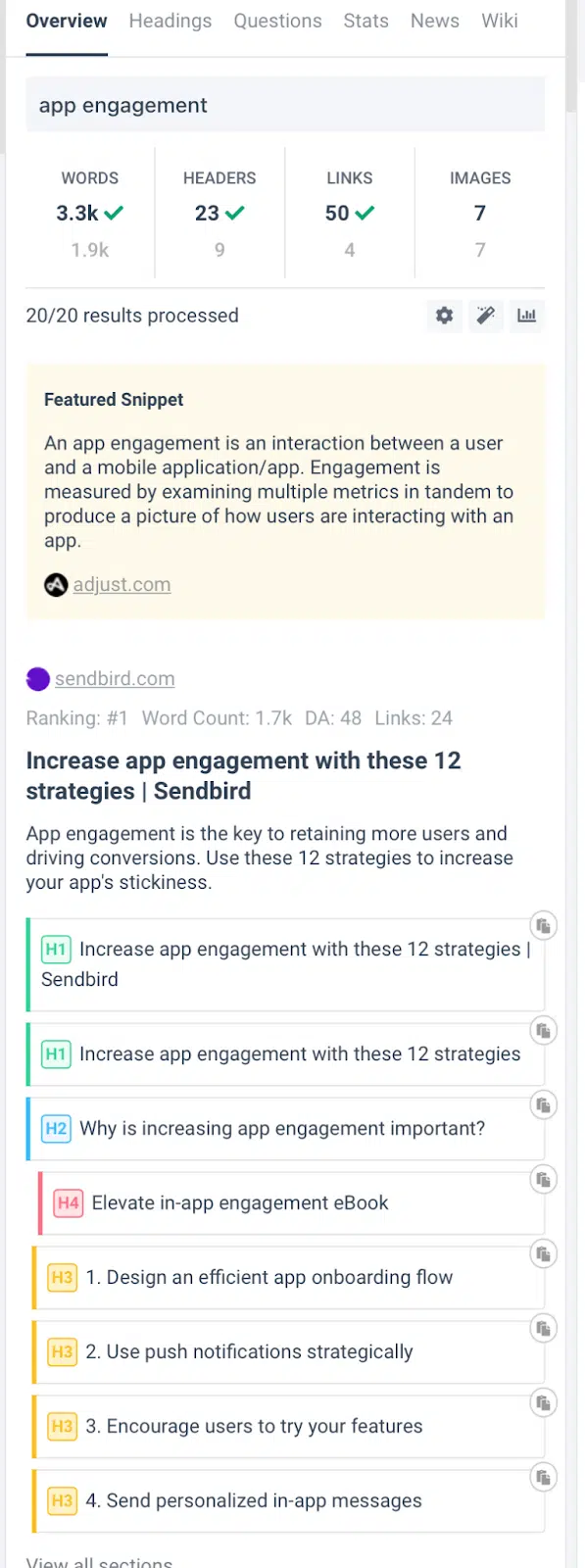
Cool. We’re at or above everyone else, for starters.
“How long should our content be?” The simplest answer is at or above the competitors. But no, it doesn’t need to be 10x the length, either.
The next step is to focus on the overall structure. For instance:
- Are the top-ranking pages content driven? If they are, don’t try to rank a product page!
- Similarly, if the top-ranking pages have commercial intent, then don’t try to rank a TOFU “what is” page, either.
Read through the top-performing competitors. Look beyond the page type into the structure of H2s and similar. Then, look into the semantic keywords – or related sub-topics – that help make sure you cover search intent.
If people search for “X,” what are the “X+1” related topics that they expect to find answers on, too?
Literally, any content optimization tool will help you find these instantly. And you should again be at or near the competition.

Last but not least, you can directly compare this content’s optimization against the “direct” SERP competitors (which might not be your own direct product competitors) to help benchmark overall performance:
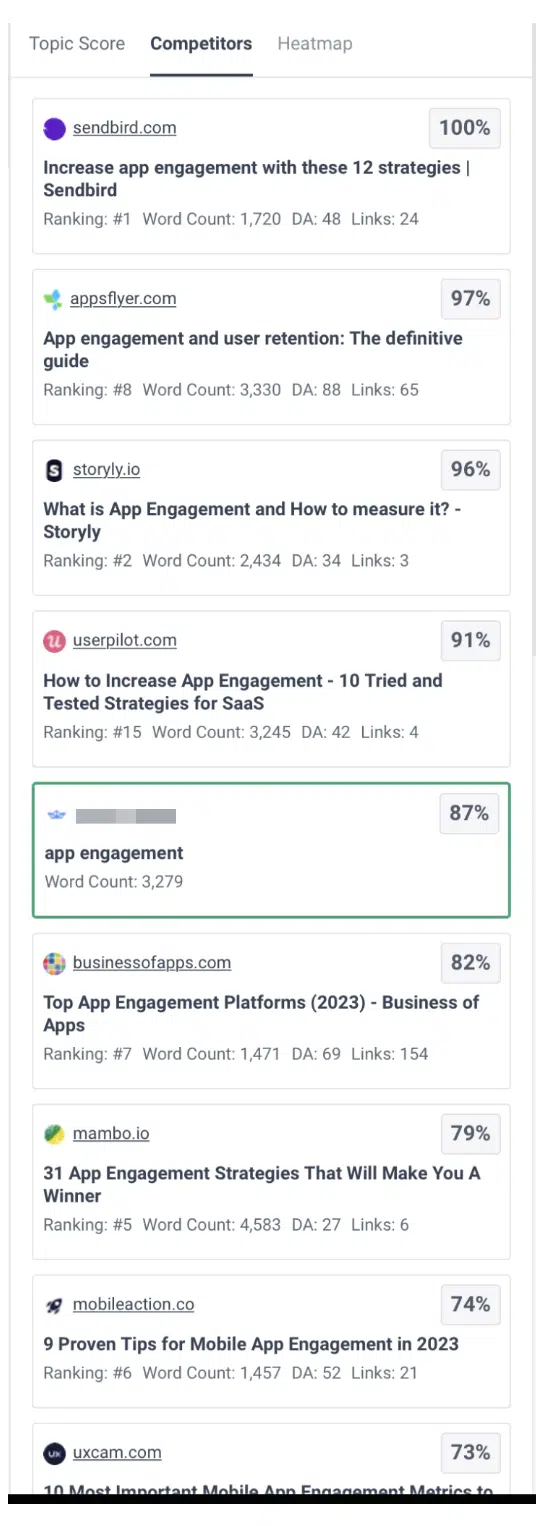
Two important caveats to optimizing content with semantic keywords:
- You should be aiming for a “B+” or “A-” overall. That means don’t optimize for 100%. Otherwise, the content comes out robotic and keyword stuffy.
- Nearly all of these tools pull semantic keywords similarly. So there’s a lot of commoditization (already) in this space. And it’s more important you focus on the overall holistic balance rather than obsessing over maxing out these scores.
So, if you’re scoring in the top three to five? That’s a pretty good start!
Again, the big “problem” preventing you from ranking probably doesn’t exist here. But maybe it’s somewhere else down below.
Question 3: Do we need multiple new pages or one in-depth?
As a general rule, more and more SERPs are trending toward prioritizing unique, narrow pages that target individual queries. (As opposed to long, in-depth pages spanning multiple related ones.)
This is backed up by analysis behind Google’s recent Helpful Content update.
This begs the question: Should this struggling page be one in-depth page vs. multiple targeting unique intents?
Let’s find out!
Take a look at what the page in question is already ranking for, and check for two things:
First, are they highly related or synonymous keywords?
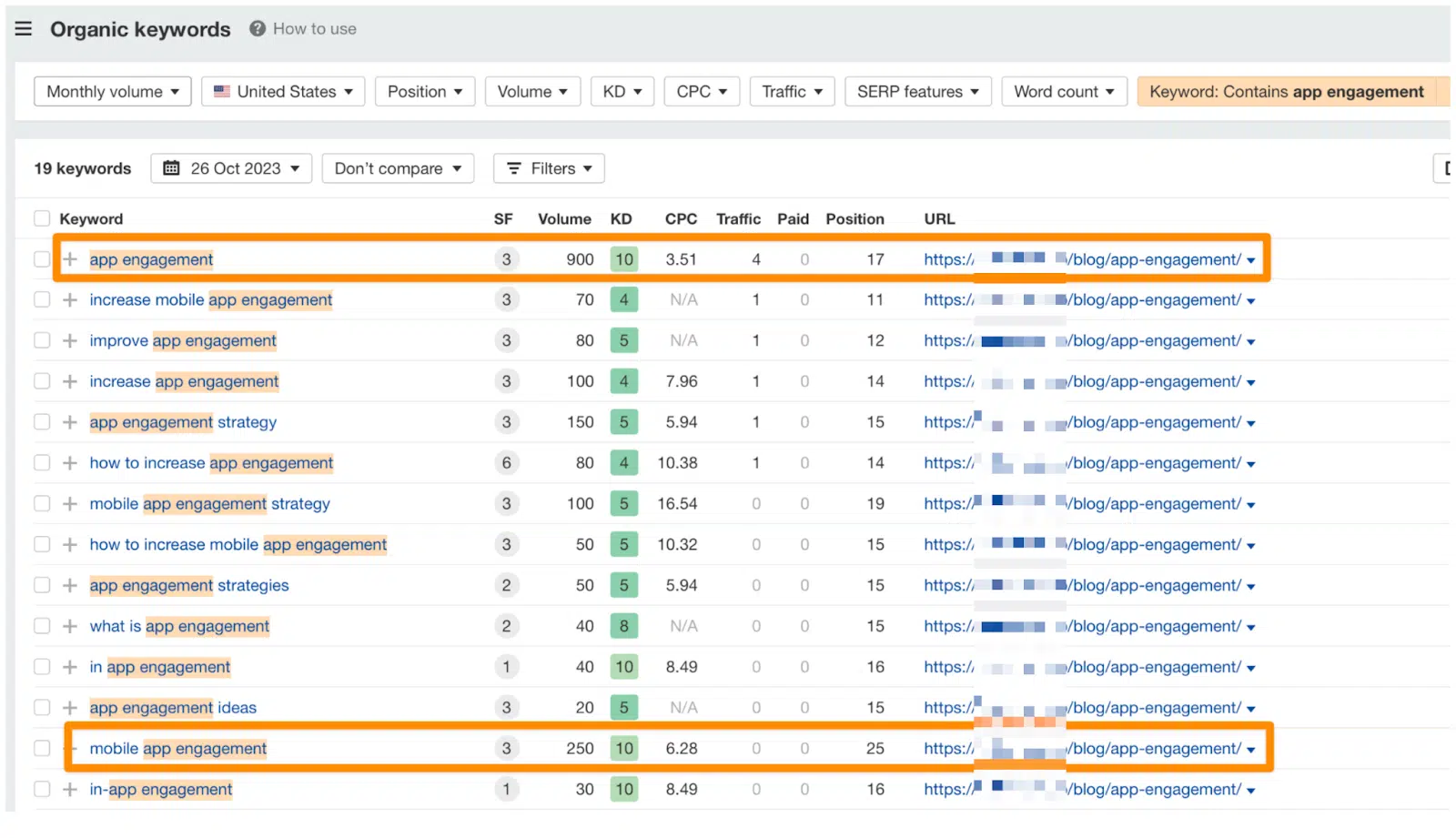
Second, let’s grab anything that looks like potential keyword cannibalization to check out the “SERP overlap” and make sure we’ve developed the content properly.
Look specifically for lots of SERP overlap (e.g., the same content pages ranking well across multiple related SERPs). If you see this, it means that one good piece is probably fine for now (vs. many targeting unique intents).

In the case of the SERP above, there’s plenty of SERP overlap of existing content. So, once again, this question isn’t our page’s primary problem, either.
Fortunately, the last two questions will help us answer why this page isn’t ranking as good as it could or should be.
Fear not, we’ll have our answer shortly!
Otherwise, this would be a pretty disappointing article at the end of the day. So I’m saving the best for last.
Question 4: Are you hitting a ‘glass ceiling’ without proper topical authority?
Topical authority acts like a “glass ceiling” for most mortal websites. (Read: Anything with a DR under 90+).
The biggest brands and sites often dominate SERPs. We can all sit around and argue whether that’s “right” or not. But I prefer to live in reality. That means two things:
- You need to build a bigger brand and site! This is why you need both “quantity” and “quality” when it comes to the long game that is SEO.
- To compete against bigger sites, you need to double down on building out topical authority to give yourself a “beachhead” foundation that will help you launch more successful attacks in the future.
Putting all of these pieces together helps you reliably predict SEO success before publishing a single article.
So let’s now turn our attention back to the article in question.
Start by actually reading through it and analyzing the sub-topics mentioned and any internal links to supporting documents that help establish topical authority on this subject.
Read between the lines, and I’m specifically talking about the content cluster you (should) have with multiple in-depth pages all working together as a rising tide lifts all boats.
You’re trying to assess the holistic way this site is covering this broad subject to see whether it’s currently doing a good job (or not).
For example, this article on “app engagement” mentions “send in-app messages” as the very first point. Good start so far!
However, what other pages on this site around “in-app messages” are helping to provide (a) more supporting material for readers and (b) helping search engines understand that this site is a deep topical expert on this space?
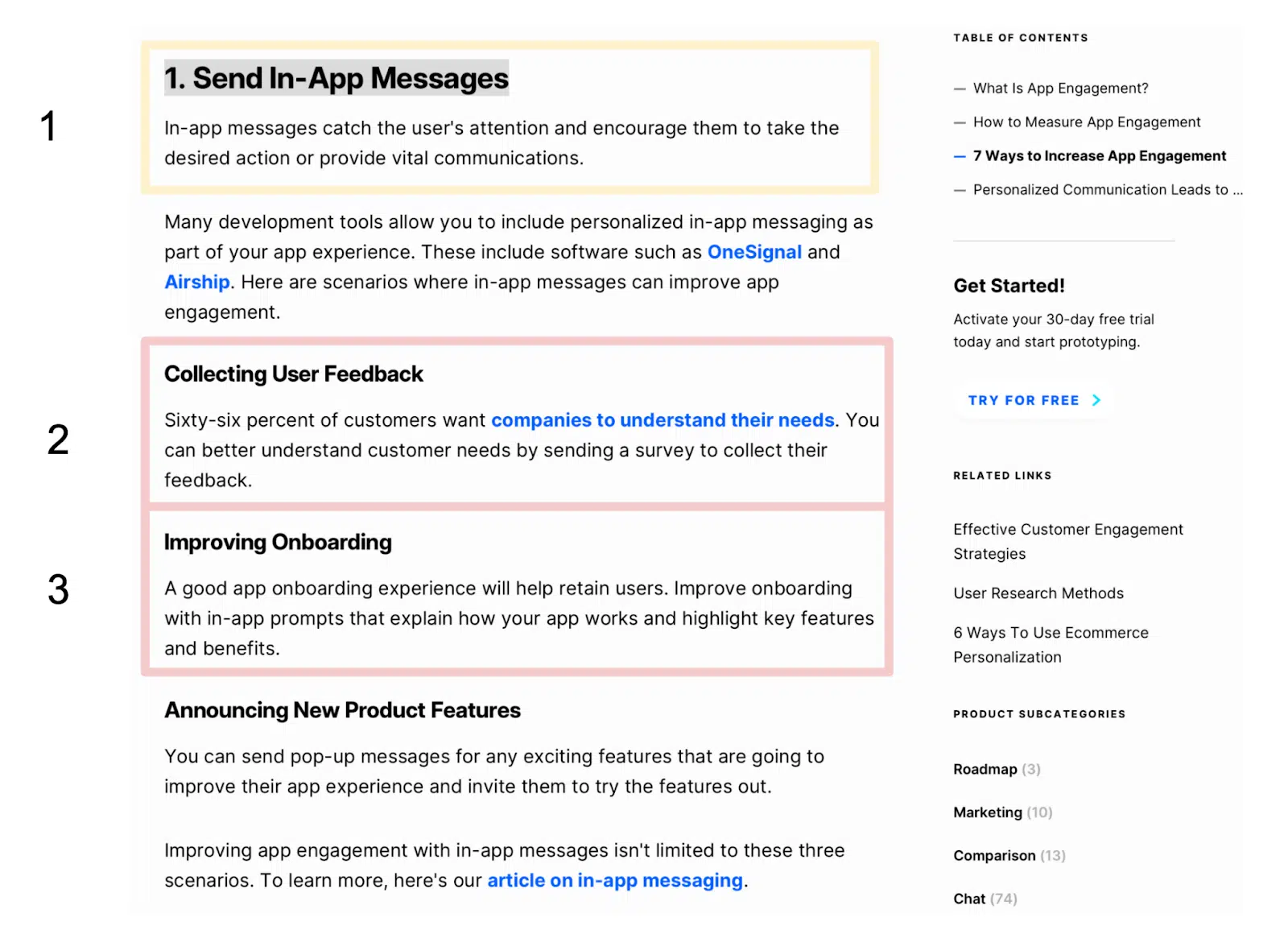
There are three areas highlighted in the example above:
- Send in-app messages.
- Collecting user feedback.
- Improving onboarding.
Question: Do we have good content already ranking on these supporting topics?
Example 1: There is a pretty good article targeting “in-app messages,” but it’s also not really ranking that well (never above position 12):

Example 2: There is no real “user feedback” content or rankings to write home about.

There is a “customer feedback” piece, but it’s outdated and misaligned with search intent.
Repeating the steps above for this new URL will tell you this almost instantly:
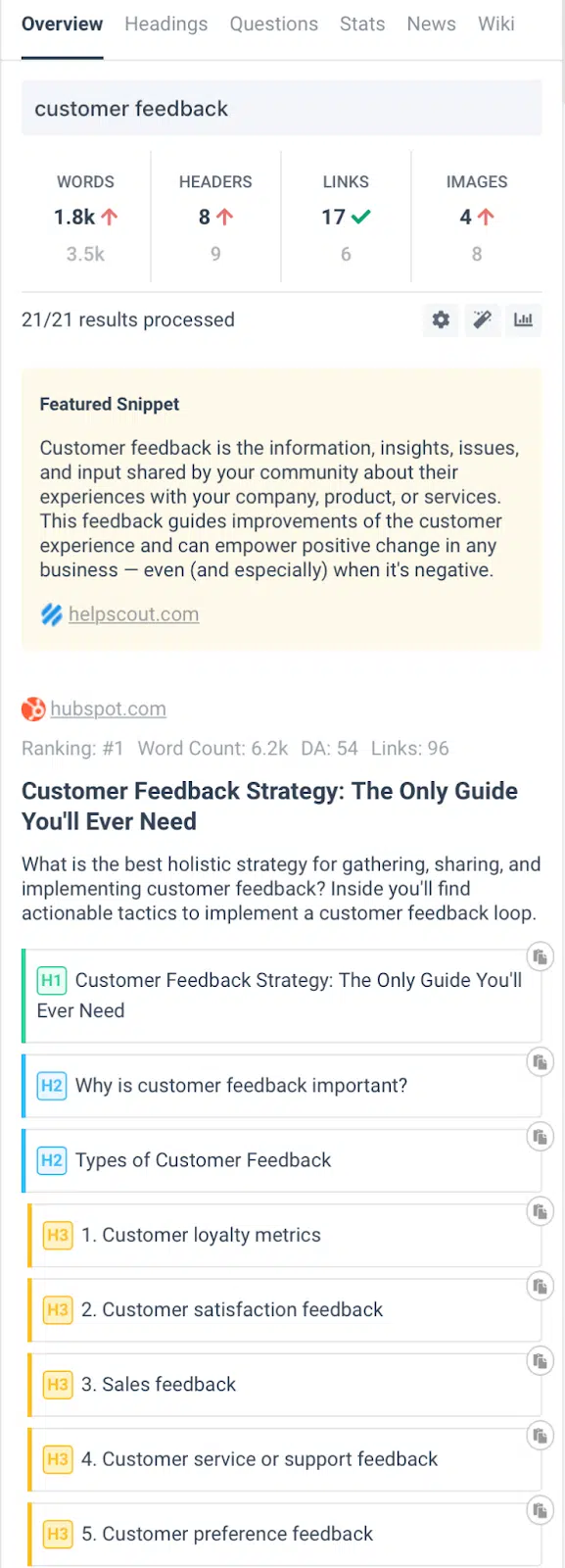
You can and should doublecheck how well this page covers semantic keywords to also quickly back this analysis up:
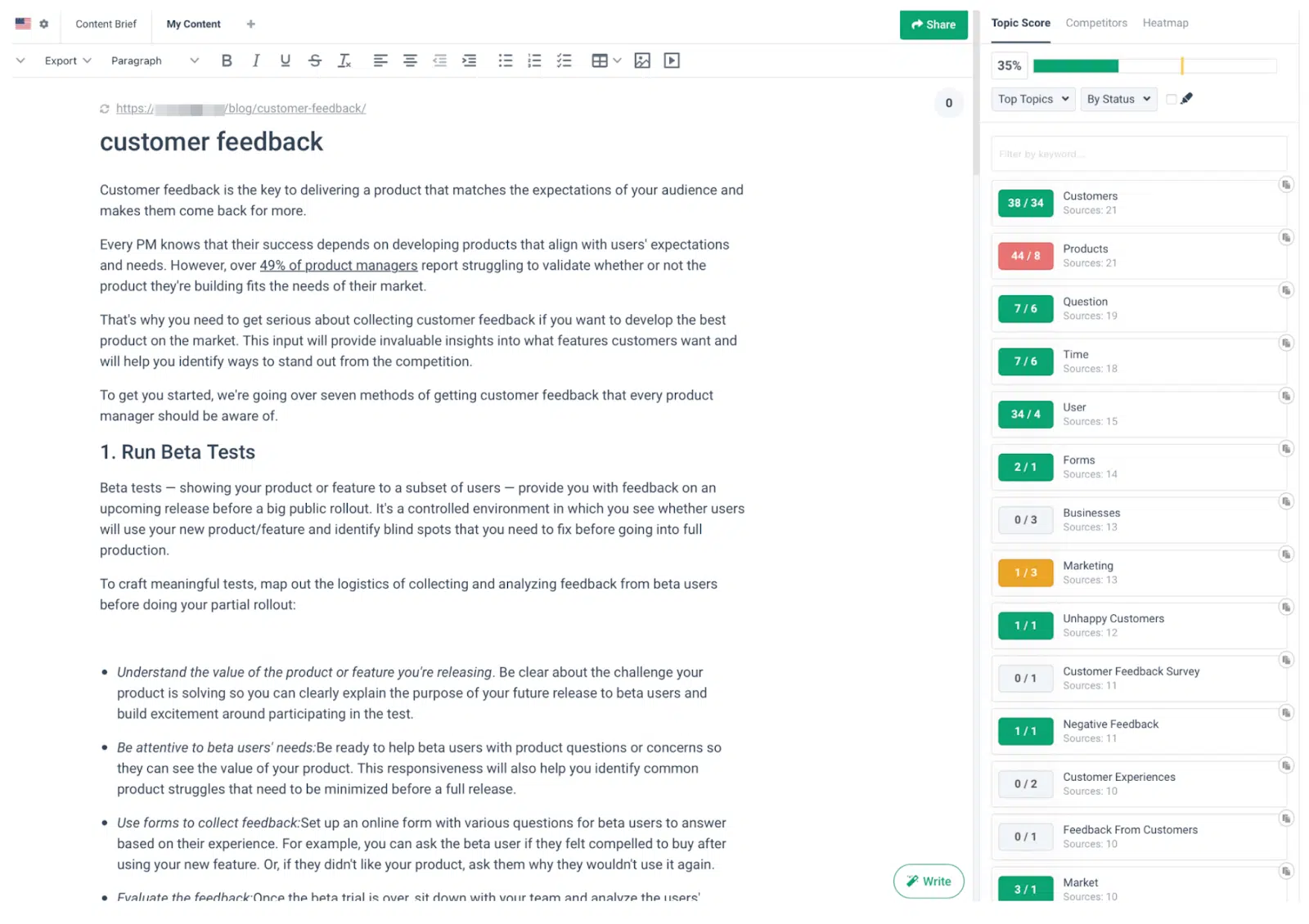
Not great! This content is both shorter than the competitor’s content, which often means it’s not doing a good job of answering the full search intent.
Both are red flags, making this page ripe for a revamp to rewrite or at least add to it ASAP.
Example 3: Similarly, there is no good “onboarding” content or rankings.
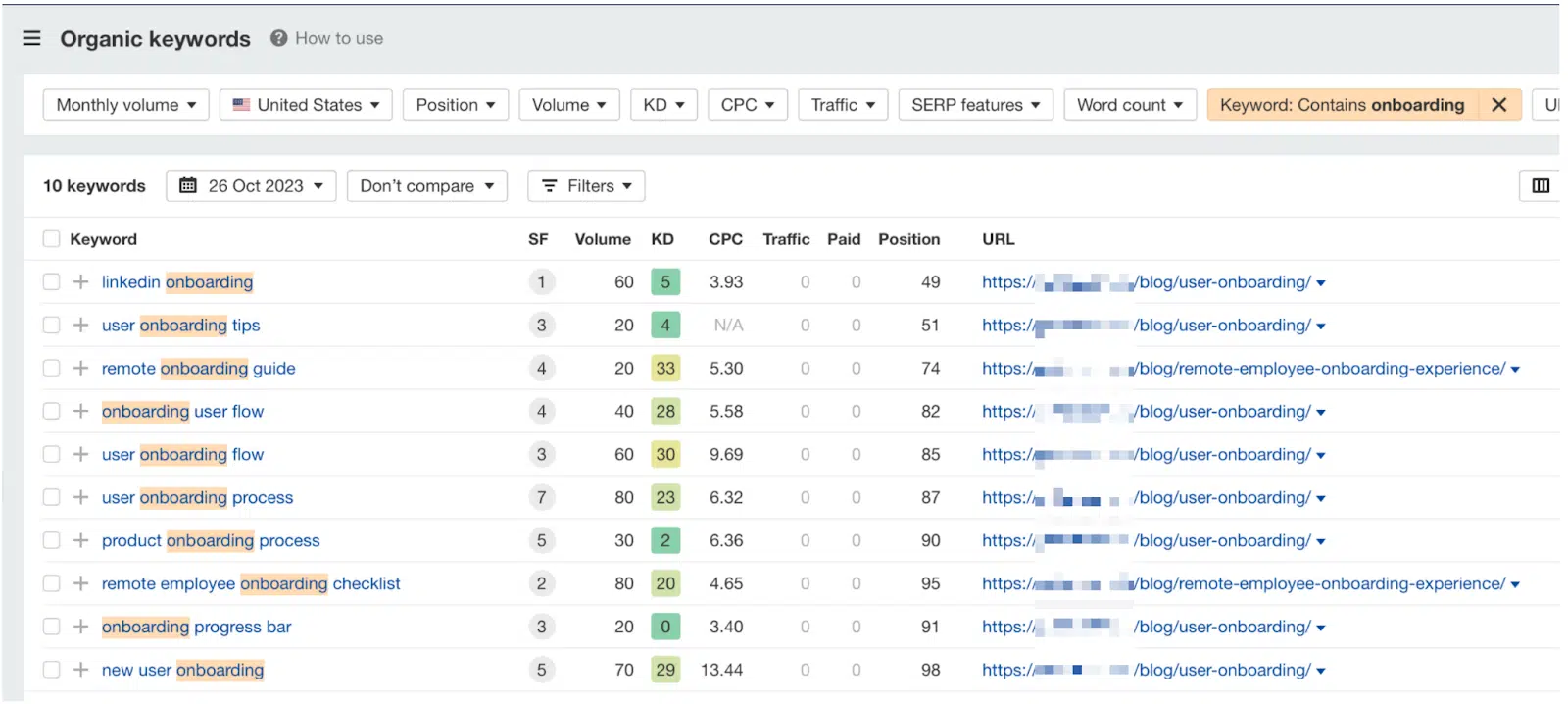
There is a “user onboarding” piece, but it struggles with the same issues as the previous example, specifically being too brief:

It’s also well under-optimized relative to the space of competing websites already ranking much better:

This one also gets flagged for a rewrite.
It also alludes to another SEO truism when competing in the Big Leagues:
You need to constantly publish content new and updating existing content at the same time!
At the end of the day, SEO is like weight loss. If you stop eating healthy and slack off on being active, that stubborn belly fat will undoubtedly come back. If you stop publishing and republishing long enough, rankings will drop and performance will suffer.
Creating an operational framework that helps you create a consistent publishing workflow makes this a breeze.
Question 5: What about off-page competitiveness (referring domain quality and quantity)?
So far, we’ve been focusing exclusively on on-site analysis.
It’s finally time to turn our attention to off-site metrics. Yes, backlinks can still make or break you in any competitive space.
In an ideal world, the best content in the world, combined with excellent topical authority, should be enough.
In competitive, red-ocean spaces? It ain’t.
Resist the urge to live in fantasy land, listening to faux-influencers on X. And talk to any real practicing SEO working in million and billion-dollar spaces.
Every single one builds links to every single important piece of content they publish.
Every. Single. One.
No ifs, ands or buts. We live in a results-driven world, and links still drive results.
And that’s why the best of the best have repeatable ways to scale high-quality links over time.
The simplest way to analyze this last point is to zero in on two basic metrics:
- Domain-level strength: DR and UR, while not the end-all, be-all of SEO, can help give you a quick proxy for whether you belong in the same ballpark (or not).
- Page-level strength: Drill into the actual quality and quantity of referring domains to each individual page ranking above you in the SERPs. (“Quality” referring to anything looking legit with a DR itself of at least 60+).
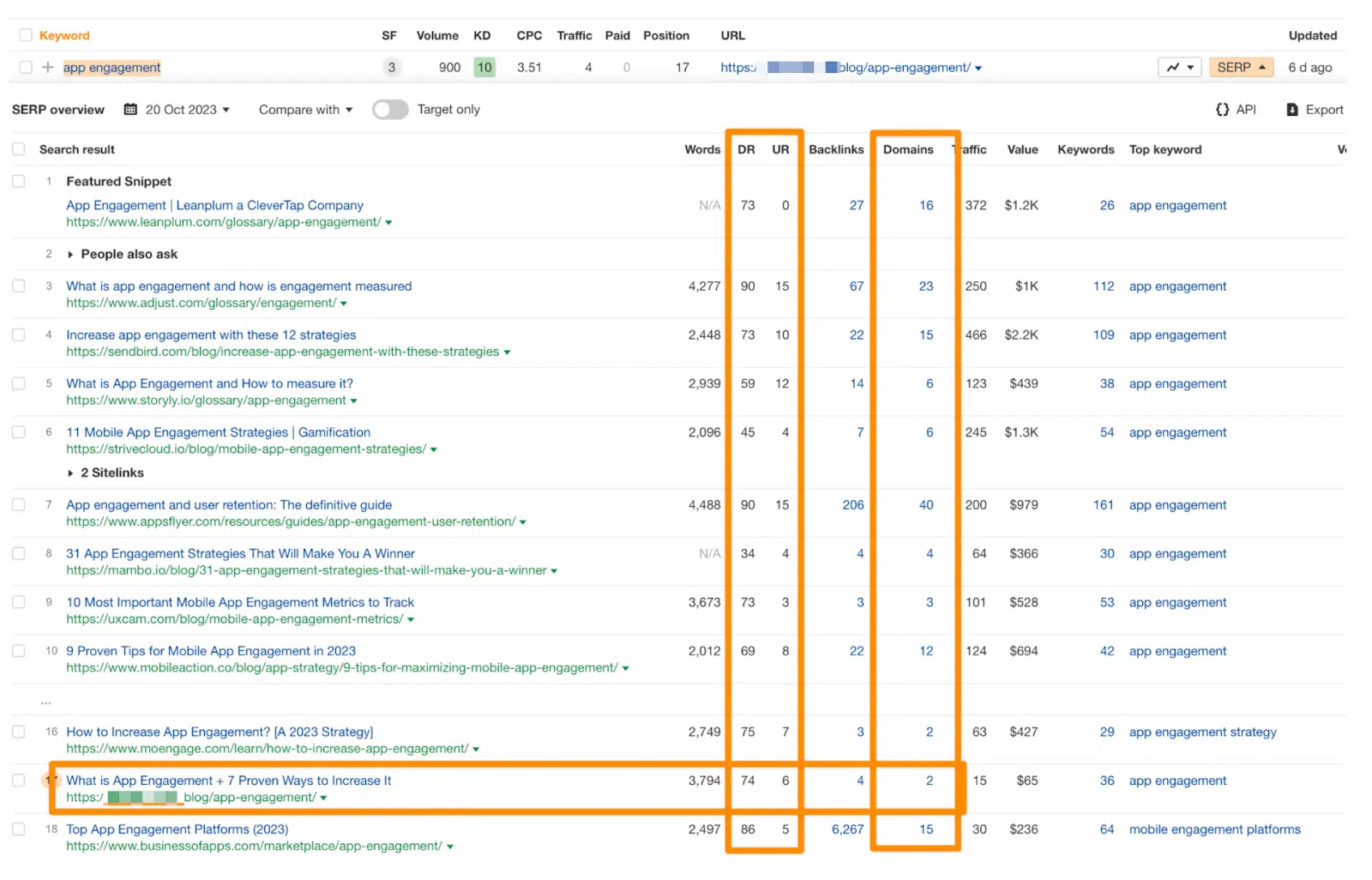
In the example above, the site in question has a DR and UR range that works. It could and should be better, but it’s OK relative to the competition for now.
However, the quality and quantity of referring domains – relative to the competitors above them – are very, very low.
This is another obvious area to improve ASAP!
And it means you need to roll up your sleeves and create another workflow to consistently generate relevant, high-quality links from reputable sites.
Diagnosing and improving your content performance
Ranking well is part art, part science.
Being 100% optimized in one particular area of ranking factors is nice. But it’s often not as good as being ~80 to 90%+ optimized across all major categories of factors.
That’s why if you see a page struggling to rank, ask yourself these five questions ASAP:
- Is the content actually good enough?
- Is it well-optimized for both readers and search engines?
- Do we need to cover the article in-depth or have multiple pages working together?
- Do we have topical authority on this subject already?
- Are we at least competitive with the competition already ranking for this page?
A balanced scorecard approach like this will quickly help you uncover obvious gaps or weaknesses.
And it’ll better focus your team’s time, attention and money to focus on what needs to be addressed immediately to drive the best, fastest turnaround.
Contributing authors are invited to create content for Search Engine Land and are chosen for their expertise and contribution to the search community. Our contributors work under the oversight of the editorial staff and contributions are checked for quality and relevance to our readers. Search Engine Land is owned by Semrush. Contributor was not asked to make any direct or indirect mentions of Semrush. The opinions they express are their own.


